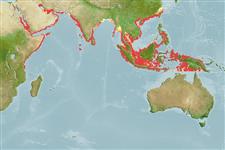Elasmobranchii (sharks and rays) >
Carcharhiniformes (Ground sharks) >
Hemigaleidae (Weasel sharks)
Etymology: Chaenogaleus: Greek, chaeno = to yawn + Greek, galeos = a kind of shark (Ref. 45335).
Environment / Climate / Range
Ecology
Marine; demersal; depth range ? - 59 m (Ref. 244). Tropical, preferred ?; 30°N - 10°S
Indo-West Pacific: Persian Gulf (Ref. 13567), Pakistan, India, Sri Lanka, Singapore, Thailand, Viet Nam, China, Taiwan, Java and Sulawesi in Indonesia. This name has been used indiscriminately for the three species of hemigaleids in Indo-Pakistani waters other than Hemipristis elongatus.
Length at first maturity / Size / Weight / Age
Maturity: Lm ?, range 68 - 97 cm
Max length : 100.0 cm TL male/unsexed; (Ref. 244)
A common inshore and offshore shark found on the continental and insular shelves (Ref. 13567). Probably feeds on small fishes, cephalopods, and crustaceans (Ref. 244). Viviparous (Ref. 50449). Caught irregularly by inshore gillnet fisheries and occasionally by small-scale longlining (Ref.58048). Probably taken by artisanal fisheries wherever it occurs (Ref. 13567). Utilized fresh for human consumption and by-products processed into fishmeal (Ref. 244).
Viviparous (with a yolk-sac placenta), with 4 young in a litter (Ref. 244). Size at birth at least 20 cm (Ref. 244). Distinct pairing with embrace (Ref. 205).
Compagno, L.J.V., 1984. FAO Species Catalogue. Vol. 4. Sharks of the world. An annotated and illustrated catalogue of shark species known to date. Part 2 - Carcharhiniformes. FAO Fish. Synop. 125(4/2):251-655. Rome: FAO. (Ref. 244)
IUCN Red List Status (Ref. 115185)
CITES (Ref. 94142)
Not Evaluated
Human uses
Fisheries: minor commercial
More information
ReferencesAquacultureAquaculture profileStrainsGeneticsAllele frequenciesHeritabilityDiseasesProcessingMass conversion
Tools
Special reports
Download XML
Internet sources
